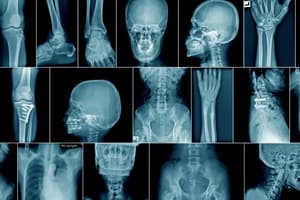Podcast
Questions and Answers
What is the most common target interaction?
What is the most common target interaction?
Bremsstrahlung
What percentage of the primary beam, when set to 80-100 keV, is bremsstrahlung photons?
What percentage of the primary beam, when set to 80-100 keV, is bremsstrahlung photons?
80-90%
All x-ray photons below 69 keV are _____________.
All x-ray photons below 69 keV are _____________.
Bremsstrahlung
What does the term Bremsstrahlung mean in German?
What does the term Bremsstrahlung mean in German?
Why do Bremsstrahlung interactions occur?
Why do Bremsstrahlung interactions occur?
What happens during a Bremsstrahlung interaction?
What happens during a Bremsstrahlung interaction?
At what point is an x-ray photon produced?
At what point is an x-ray photon produced?
As the incident electron slows down, it loses ___________ energy.
As the incident electron slows down, it loses ___________ energy.
Does the incident electron ever reach the nucleus?
Does the incident electron ever reach the nucleus?
Brems interactions ONLY occur when the incident electron interacts with the ________________.
Brems interactions ONLY occur when the incident electron interacts with the ________________.
Why are Bremsstrahlung interactions considered to be heterogenetic/polyenergetic?
Why are Bremsstrahlung interactions considered to be heterogenetic/polyenergetic?
What contributes to the differential absorption of x-rays within the patient's body?
What contributes to the differential absorption of x-rays within the patient's body?
As incident electrons get closer to the nucleus of an atom, a (smaller/larger) deflection of the incident electron occurs.
As incident electrons get closer to the nucleus of an atom, a (smaller/larger) deflection of the incident electron occurs.
The larger the deflection, the (less/more) energy transferred to the photon.
The larger the deflection, the (less/more) energy transferred to the photon.
The energy of the brems photon is exactly the difference between the entering and exiting electron's ______________ energy.
The energy of the brems photon is exactly the difference between the entering and exiting electron's ______________ energy.
A Brem's photon with high energy will have a _______________ frequency and a ________________ wavelength.
A Brem's photon with high energy will have a _______________ frequency and a ________________ wavelength.
Photon's frequency is __________________ related to its wavelength.
Photon's frequency is __________________ related to its wavelength.
Bremsstrahlung is also known as ____________ or _____________ radiation.
Bremsstrahlung is also known as ____________ or _____________ radiation.
Operating at 90 kVp, we will have Brem's photons that range from __________ to __________ kVp.
Operating at 90 kVp, we will have Brem's photons that range from __________ to __________ kVp.
The majority of the Brem's photons will have approximately _________ of the max energy in a single exposure.
The majority of the Brem's photons will have approximately _________ of the max energy in a single exposure.
What effect does binding energy have on Brem's interactions?
What effect does binding energy have on Brem's interactions?
The higher the atomic number of the target material, the more _________________ the Brem's photon becomes.
The higher the atomic number of the target material, the more _________________ the Brem's photon becomes.
Incident electron enters with 100 keV and leaves with 50 keV. How much energy is possessed by the brem's photon released in this interaction?
Incident electron enters with 100 keV and leaves with 50 keV. How much energy is possessed by the brem's photon released in this interaction?
An electron is deflected by a nucleus in a tungsten atom (atomic # 74). The electron had 125 keV initially and after interaction now had 45 keV. What is the energy of the brems x-ray as a result of this interaction?
An electron is deflected by a nucleus in a tungsten atom (atomic # 74). The electron had 125 keV initially and after interaction now had 45 keV. What is the energy of the brems x-ray as a result of this interaction?
What makes up the y-axis on an x-ray emission spectrum?
What makes up the y-axis on an x-ray emission spectrum?
What makes up the x-axis of an x-ray emission spectrum?
What makes up the x-axis of an x-ray emission spectrum?
Brem's x-ray photons have a ___________________ spectrum.
Brem's x-ray photons have a ___________________ spectrum.
Flashcards are hidden until you start studying
Study Notes
Bremsstrahlung Overview
- Bremsstrahlung, meaning "breaking" or "slowing" in German, is the most common target interaction in x-ray production.
- 80-90% of the primary beam at 80-100 keV is composed of Bremsstrahlung photons.
- All x-ray photons below 69 keV are classified as Bremsstrahlung, since characteristic photons require at least this energy to dislodge K shell electrons.
Mechanism of Bremsstrahlung Interactions
- Bremsstrahlung occurs when an incident electron is attracted to the positively charged nucleus, interacting with its electrostatic force field instead of colliding with another electron.
- During the interaction, the incident electron slows down, losing kinetic energy, which is converted into an x-ray photon when deflected by the nucleus.
- The incident electron never reaches the nucleus due to insufficient strength.
Photons Characteristics
- Brems photons are heterogeneous or polyenergetic, producing a wide range of x-ray photon energies due to varying distances from the nucleus during each interaction.
- A higher deflection results in a larger energy transfer to the photon, with high-energy Brems photons exhibiting higher frequency and shorter wavelength.
- Photon frequency is inversely related to wavelength; as frequency increases, wavelength decreases.
Energy Dynamics
- The energy of a Brems photon equals the difference between the entering and exiting kinetic energy of the incident electron.
- Operating at 90 kVp, Brems photons can range from 0 to 90 keV, with the majority possessing one-third of the maximum energy in a single exposure (e.g., at 90 kVp, the most common photons will be approximately 30 keV).
Influence of Atomic Number and Binding Energy
- Higher atomic number materials are more efficient in producing Brems photons, although they do not directly increase photon energy; that occurs during characteristic interactions.
- Binding energy does not affect Brems interactions, as these do not occur with electrons in orbit around the nucleus.
X-ray Emission Spectrum
- The y-axis of an x-ray emission spectrum represents the number of x-rays produced (mAs), indicating quantity.
- The x-axis reflects the energy level of the beam (kVp), representing quality.
- Bremsstrahlung x-ray photons create a continuous spectrum, indicating a variety of photons with differing energies below the maximum curve.
Example Calculations
- In an interaction where an electron enters with 100 keV and exits with 50 keV, the resulting Brems photon has an energy of 50 keV.
- For a tungsten atom (atomic # 74), if an electron with 125 keV is deflected and leaves with 45 keV, the energy of the emitted Brems x-ray is 80 keV, showcasing that atomic number does not influence the photon energy in this calculation.
Studying That Suits You
Use AI to generate personalized quizzes and flashcards to suit your learning preferences.






